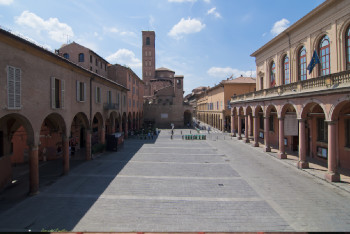At the end of the 14th century (1394), yet another political transformation took place: under the Gonfaloniere of Justice and the Papal legate, sixteen Reformers were elected from among nobles and commoners to join the new communal council.
Within this group of “new men”, who were often chosen from among the graduates of the Studium, the city’s new oligarchy arose. Covetous of its privileges, it caused sudden social restrictions, which only ended with the arrival of Napoleon Bonaparte.

The professors became public employees, paid with income from the Gabella Grossa (tax on goods). This inevitably led, on the one hand, to the subjugation of professorships and degree programmes and, on the other hand, to foreign teachers being sent away who, in previous seasons, had enriched the quality of the teaching. With a few exceptions (no more than four “eminent readings” were reserved for foreigners: Civil Law, Humanities, Philosophy and Medicine), only Bologna-born teachers could now teach at the Studium, which was therefore doomed to provincialism and local teachers were slowly falling into expediency and opportunism. In fact, they were often not up to previous standards, especially after the nobles were granted the right to teach only by virtue of their social class.
In the meantime, the resilient and successful policy of the popular Bentivoglio family took hold. Over the course of a few generations, they managed to impose their power, which was accepted by popes and respected by other noble courts.
At this time, Bologna went back to being a vibrant and lively cultural metropolis, and its squares, buildings and churches were modernised.
In fact, the lords of Bologna were ready for the arrival of the Renaissance, and so were their circle of intellectuals, who legitimised their power through poems, paintings and music.
The Studium also revolved around this powerful family and exchanged favours and benefits with them, inspired by the same diverse and multifaceted culture.
Notable names such as Leon Battista Alberti and Giovanni Pico della Mirandola continued to graduate from the Università dei Legisti (Universities of Jurors), whereas the Università degli Artisti (University of Artists) was enriched with new prestigious professorships: Music (the first in Europe), Mathematics and Astronomy (1451), Greek Language and Literature (1453), Hebrew Language and Literature (1464) and Metaphysics (1466).
This was the period of the revival of Literature, Philosophy, Astronomy and Medicine. This was the time of Renaissance Humanism.
Francesco del Pozzo, Filippo Beroaldo, Giovanni Garzoni, Alessandro Achillini, Urceo Codro and Domenico Maria da Novara were able to lure Nicolaus Copernicus, who had been in Bologna for some time to study law. They introduced him to Neoplatonism and Neopythagoreanism, through which he would soon turn humanity’s view of the universe upside down.
